货船全封闭重力式救生艇和兼作救生艇的救助艇的区别
陆相辉
在国际航行货船上,全封闭重力式救生艇是较为普遍的,尤其是在集装箱船上,通常会设有两艘全封闭重力式救生艇,其中一艘兼作救助艇。那么货船全封闭重力式救生艇和兼作救生艇的救助艇到底有什么区别呢?
一、定义
1、救生艇定义
SOLAS CIII/R3.23救生艇筏系指从弃船时起能维持遇险人员生命的艇。
Survival craft is a craft capable of sustaining the lives of persons in distress from the time of abandoning the ship.
2、救助艇定义
SOLAS CIII/R3.19救助艇系指为救助遇险人员及集结救生艇筏而设计的艇。
Rescue boat is a boat designed to rescue persons in distress and to marshal survival craft.
一般情况下,右舷救生艇是1号艇,左舷救生艇是2号艇,具体哪艘兼作救助艇,要看本船的救生系统设备分布图,如图一和图二所示,我轮左舷2号救生艇兼作救助艇。
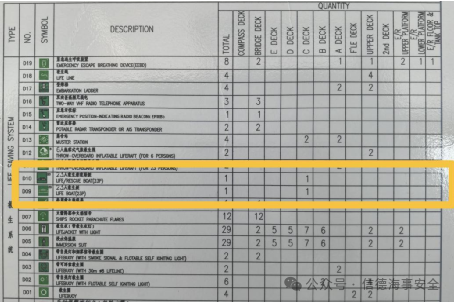
图一
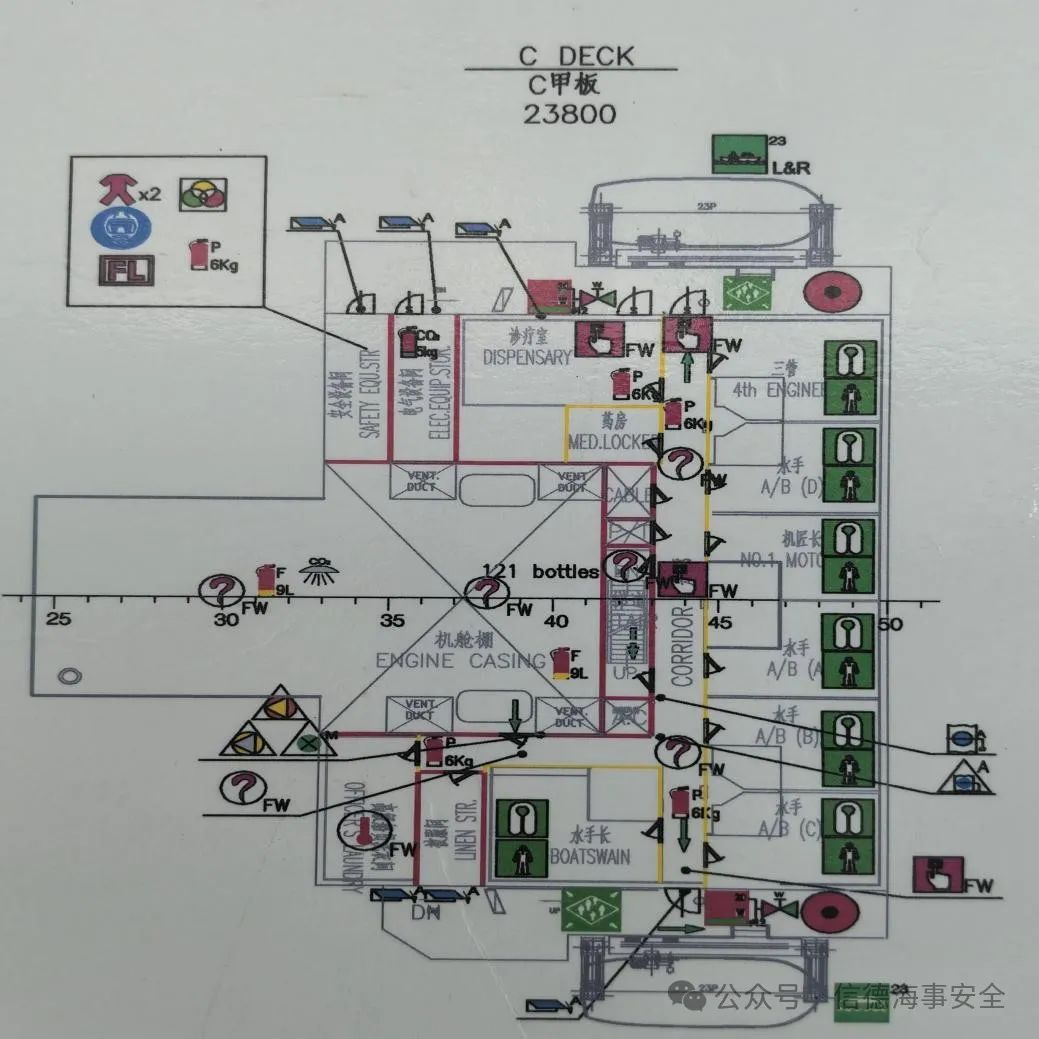
图二
二、救生艇兼作救助艇的条件
1、SOLAS CIII/R14.4
救助艇的存放应在其兼作救生艇时,符合第13条(救生艇筏的存放)的要求。
Rescue boats shall be stowed if it is also a lifeboat, in compliance with the requirements of regulation 13(Stowage of survival craft).
备注:
(1)救生艇筏的存放
SOLAS CIII/R13.1.3每艘救生艇筏的存放应持续处于准备就绪状态,使2名船员能在5min内完成登乘和降落准备工作。
Each survival craft shall be stowed in a state of continuous readiness so that two crew members can carry out preparations for embarkation and launching in less than 5 min.
(2)救助艇的存放
SOLAS CIII/R14.1救助艇的存放应持续处于准备使用状态,不超过5min即可降落。
Rescue boats shall be stowed in a state of continuous readiness for launching in not more than 5 min.
两者都是需要不超过5min的准备工作时间,但是救助艇的要求中没有规定需要几个人,再根据SOLAS CIII/R14.4规定,表明兼作救生艇的救助艇同样是需要2个人进行不超过5min的准备工作。
2、SOLAS CIII/R17.2
如救助艇是船舶救生艇筏中的一艘,其登乘装置与降落站应符合第11条(救生艇筏的集合与登乘布置/Survival craft muster and embarkation arrangements)和第12条(降落站/Launching stations)的要求。
If the rescue boat is one of the ship’s survival craft, the embarkation arrangements and launching station shall comply with the requirements of regulations 11 and 12.
3、SOLAS CIII/R17.3
降落装置应符合第16条(救生艇筏的降落与回收装置/Survival craft launching and recovery arrangements)的要求。
Launching arrangements shall comply with the requirements of regulation 16.
4、SOLAS CIII/R31.2
货船应至少配备一艘符合LSA CODE第5.1节要求的救助艇。如果救生艇及其降落和回收装置也符合对救助艇的要求,则可以接受此救生艇作为救助艇。
Cargo ships shall carry at least one rescue boat complying with the requirements of section 5.1 of the LSA Code. A lifeboat may be accepted as a rescue boat, provided that it and its launching and recovery arrangements also comply with the requirements for a rescue boat.
5、LSA CODE CV/5.1.1.1
除本节规定的以外,所有救助艇都应符合第4.4.1款~第4.4.7.4款(第4.4.6.8款除外),以及第4.4.7.6、4.4.7.7、4.4.7.9、4.4.7.10款及4.4.9款的要求,例外的是,对于所有救助艇,平均质量82.5kg须对4.4.2.2.1段适用。如果它符合本节的所有要求,成功地完成第Ⅲ/4.2条中要求的救助艇试验,船上的存放、降落和回收装置均符合救助艇的所有要求,则救生艇可予作为救助艇。
Except as provided by this section, all rescue boats shall comply with the requirements of paragraphs 4.4.1 to 4.4.7.4 inclusive (excluding paragraph 4.4.6.8), and 4.4.7.6, 4.4.7.7, 4.4.7.9, 4.4.7.10 and 4.4.9, except that, for all rescue boats, an average mass of 82.5kg shall apply to paragraph 4.4.2.2.1. A lifeboat may be approved and used as a rescue boat if it meets all of the requirements of this section, if it successfully completes the testing for a rescue boat required in regulation Ⅲ/4.2, and if its stowage, launching and recovery arrangements on the ship meet all of the requirements for a rescue boat.
备注:本款规定中的Ⅲ/4.2是指SOLAS CIII/4.2。
救生艇若要兼作救助艇,需要同时满足上述5处规定,即要同时满足救助艇在存放、集合、登乘、降落站 、降落和回收装置方面的要求。然而,救助艇还有一些要求,是区别于救生艇的。
三、SOLAS CIII/R17救助艇的登乘、降落与回收装置
本条都是在说明救助艇的规定,兼作救生艇的救助艇除了满足SOLAS CIII/R16(救生艇筏的降落与回收装置)的规定之外,还要满足SOLAS CIII/R17的要求,现在来具体分析本条的5款规定。
1、SOLAS CIII/R17.1
救助艇的登乘与降落装置,应使救助艇能在尽可能短的时间内登乘和降落。
The rescue boat embarkation and launching arrangements shall be such that the rescue boat can be boarded and launched in the shortest possible time.
本条规定要求应使救助艇能在尽可能短的时间内登乘和降落,但并没有具体要求多少时间。
再根据LSA CODE CIV/4.4.3.2每艘货船救生艇的布置,应使其全部乘员在从发出登艇指示时间起不超过3分钟登艇完毕。尚应可能迅速离艇。
Every cargo ship lifeboat shall be so arranged that it can be boarded by its full complement of persons in not more than 3 min from the time the instruction to board is given. Rapid disembarkation shall also be possible.
从上述两款规定可以推断,兼作救生艇的救助艇在执行救生任务时,登乘时间和救生艇一样,也应不超过3分钟;在其执行救助任务时,登乘时间在理论上来讲应该是要少于在执行救生任务时的时间,因为执行救生任务时,是要求全部乘员登艇,而执行救助任务时,没有要求全部乘员登艇,只是要求数名需要现场救助的随艇下人员登艇,但是具体需要多久,没有明确规定。
而降落时间的要求还未知,因此再来分析其他规定。
LSA CODE CVI/6.1.2.1
除了自由降落救生艇的次要降落设备以外,使用吊艇索和绞车的降落设备除应符合6.1.1的要求外,还应符合本款的要求。
Every launching appliance using falls and a winch, except for secondary launching appliances for free-fall lifeboats, shall comply with the requirements of paragraph 6.1.1 and, in addition, shall comply with the requirements of this paragraph.
LSA CODE CVI/6.1.2.8
满载救生艇筏或救助艇降落下水的速度,应不小于由下列公式得出的速度:

式中:
S—下降速度,m/s;
H—从吊艇架顶部到最轻载航行水线的距离,m。
The speed at which the fully loaded survival craft or rescue boat is lowered to the water shall not be less than that obtained from the formula:
S = 0.4 + 0.02H
Where:
S is the lowering speed in meters per second and
H is the height in meters from the davit head to the waterline with the ship at the lightest sea-going condition.
LSA CODE CVI/6.1.2.9
配备全部属具但不载人员救生筏的降落速度应使主管机关满意。配备全部属具但不载人员的其他救生艇筏的降落速度应不少于6.1.2.8要求的70%。
The lowering speed of a fully equipped liferaft without persons onboard shall be to the satisfaction of the Administration. The lowering speed of other survival craft, fully equipped but without persons on board, shall be at least 70% of that required by paragraph 6.1.2.8.
从LSA CODE CVI/6.1.2.1,6.1.2.8,6.1.2.9的这三处规定可以得知,公约对全封闭重力式救生艇和兼作救生艇的救助艇在降落方面的要求是一致的。
因此,SOLAS CIII/R17.1不是两者区别。
2、SOLAS CIII/R17.2
如救助艇是船舶救生艇筏中的一艘,其登乘装置与降落站应符合第11条(救生艇筏的集合与登乘布置)和第12条(降落站)的要求。
If the rescue boat is one of the ship’s survival craft, the embarkation arrangements and launching station shall comply with the requirements of regulations 11(Survival craft muster and embarkation arrangements) and 12(Launching stations).
前文已经陈述,本款SOLAS CIII/R17.2是在说明相同点,而不是区别。
3、SOLAS CIII/R17.3
降落装置应符合第16条的要求。但是,所有救助艇均应能在船舶于平静水面上前进航速达到5kn时降落,必要时可利用艇首缆。
Launching arrangements shall comply with the requirements of regulation 16. However, all rescue boats shall be capable of being launched, where necessary utilizing painters, with the ship making headway at speeds up to 5 knots in calm water.
本款规定中有个“但是”,是在强调救助艇的特定要求,再来分析其他条款,确定本款规定是否为两者区别。
SOLAS CIII/R33.2在20000GT及以上的货船上,吊艇架降落救生艇应能在该船于平静水域前进速度达5kn时降落,必要时可利用艇首缆。
On cargo ships of 20,000 gross tonnage and upwards, davit-launched lifeboats shall be capable of being launched, utilizing painters where necessary, with the ship making headway at speeds up to 5 knots in calm water.
从上述两款规定可以看出,20000GT及以上货船的救生艇和500GT及以上货船的救助艇,应能在该船于平静水域前进速度达5kn时降落,必要时可利用艇首缆。而500GT及以上且小于20000GT的货船的救生艇没有此项要求。(注意:根据SOLAS CI/R3(a)除另有明文规定外,本规则不适用于小于500GT的货船。The present regulations, unless expressly provided otherwise, do not apply to cargo ships of less than 500 gross tonnage. )
再来分析LSA CODE的规定:
LSA CODE CIV/4.4.1.3所有救生艇应具有足够的强度:
.1 载足全部乘员及属具后能安全降落水中;
.2 除自由降落式救生艇外,在船舶以达 5 kn的航速在平静水面前进时能够降落和被拖带。
All lifeboats shall be of sufficient strength to:
.1 enable them to be safely launched into the water when loaded with their full complement of persons and equipment; and
.2 except for free-fall lifeboats, be capable of being launched and towed when the ship is making headway at a speed of 5 knots in calm water.
本款规定并没有要求货船的总吨吨位,也就是说适用于500GT及以上货船的除自由降落救生艇以外的其他种类救生艇。
从上述三款规定可以得知,500GT及以上货船的全封闭重力式救生艇和兼作救生艇的救助艇,在船舶以达 5 kn的航速在平静水面前进时能够降落和被拖带。也就是说,SOLAS CIII/R17.3并不是两者的区别。同时,也可以得知,20000GT及以上货船的自由降落式救生艇,应能在该船于平静水域前进速度达5kn时降落,必要时可利用艇首缆。
4、SOLAS CIII/R17.4
救助艇在载足额定乘员及属具时的中等海况下的回收时间应不超过5min。如救助艇兼作救生艇,应能在此时间内回收载有救生艇属具及认可额定乘员(至少为6人)的救助艇。
Recovery time of the rescue boat shall be not more than 5 min in moderate sea conditions when loaded with its full complement of persons and equipment. If the rescue boat is also a lifeboat, this recovery time shall be possible when loaded with its lifeboat equipment and the approved rescue boat complement of at least six persons.
SOLAS CIII/R3.18
救助艇的回收时间系指该艇被提升至某一位置,而使艇上人员可从该处登上大船甲板所需要的时间。回收时间包括在救助艇上做的回收准备工作所需的时间,诸如抛投和系住首缆,连接救助艇与降落设备,以及提升救助艇的时间。回收时间不包括把降落设备降低至回收救助艇的位置所需要的时间。
Recovery time for a rescue boat is the time required to raise the boat to a position where persons on board can disembark to the deck of the ship. Recovery time includes the time required to make preparations for recovery on board the rescue boat such as passing and securing a
painter, connecting the rescue boat to the launching appliance, and the time to raise the rescue boat. Recovery time does not include the time needed to lower the launching appliance into position to recover the rescue boat.
LSA CODE CVI/6.1.1.8
救生艇降落设备应能收回载有艇员的救生艇。
A lifeboat launching appliance shall be capable of recovering the
lifeboat with its crew.
LSA CODE CVI/6.1.1.9
每艘救助艇降落设备都应装设一台能把载足全部乘员和设备的救助艇从水面以不少于0.3m/s的速率升起的动力驱动的绞车马达。
Each rescue boat launching appliance shall be fitted with a powered winch motor capable of raising the rescue boat from the water with its full rescue boat complement of persons and equipment at a rate of not less than 0.3 m/s.
SOLAS和LSA CODE并没有救生艇回收时间的具体规定,只要能够安全回收即可满足要求,而救助艇系指为救助遇险人员及集结救生艇筏而设计的艇,为了达到救助艇快速回收的要求,一般情况下,救助艇的回收遥控装置(图三)上设有两个按键:“低速起升”和“高速起升”,区别于救生艇回收遥控装置的一个按键:“起升”(图四)。
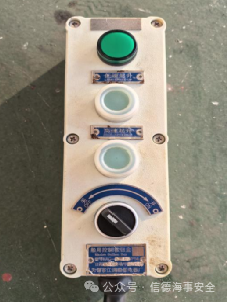
图三
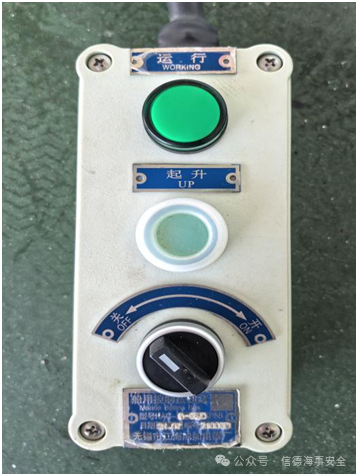
图四
另一种设置是救助艇和救生艇的回收遥控装置是一样的(图五),而在救助艇绞车制动器附近有个转换开关(图六、图七),标明“低速”和“高速”两个位置。
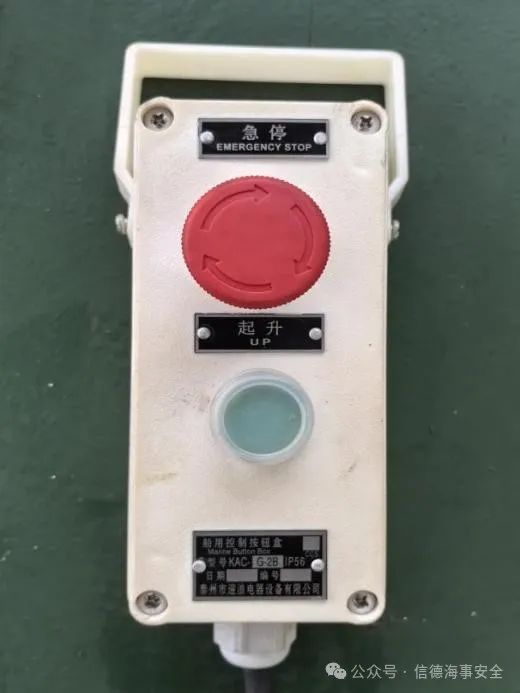
图五
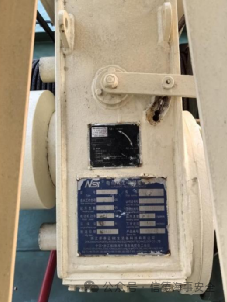
图六
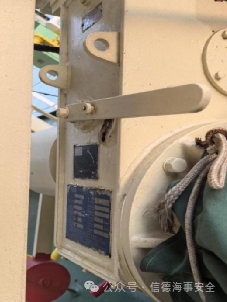
图七
5、SOLAS CIII/R17.5
救助艇登乘和回收装置应能做到安全而有效地搬运担架病人。如果重型动索滑车构成危险,为安全起见应设有供恶劣天气下使用的回收环索。
Rescue boat embarkation and recovery arrangements shall allow for safe and efficient handing of a stretcher case. Foul weather recovery strops shall be provided for safety if heavy fall blocks constitute a danger.
SOLAS CIII/R11.6吊艇架降落和自由降落的救生艇筏集合站与登乘站的布置,应能使担架病人抬进救生艇筏。
Davit-launched and free-fall launched survival craft muster and embarkation stations shall be so arranged as to enable stretcher cases to be placed in survival craft.
LSA CODE CIV/4.4.3.4救生艇的布置,应能把失去自主能力的人员从海上或从所躺的担架上抬进救生艇。
The lifeboat shall be so arranged that helpless people can be brought on board either from the sea or on stretchers.
LSA CODE CVI/6.1.1.11救助艇降放设备应配备用以在重力动索滑车构成危险时的恶劣天气收回救助艇的收回环索。
Rescue boat launching appliances shall be provided with foul weather recovery strops for recovery where heavy fall blocks constitute a danger.
从上述四款规定可以得知,救生艇和救助艇的登乘和回收装置都应能做到安全而有效地搬运担架病人,因全封闭重力式救助艇有可以构成危险的重型动索滑车,为安全起见,还应配备供恶劣天气下使用的回收环索(图八)。
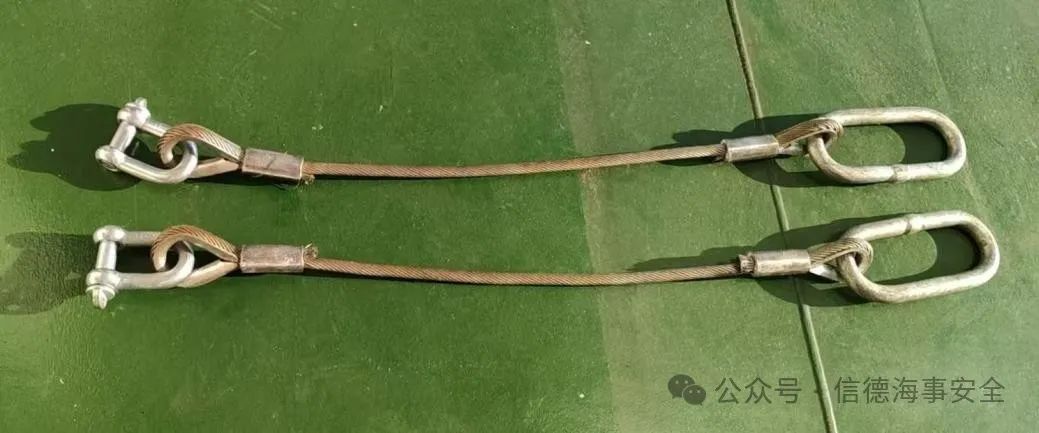
图八
备注:
根据SOLAS公约1996年修正案(MSC.47(66)),公约第Ⅲ章作了全面修订,增加了SOLAS CIII/R17.5的要求,该要求适用于1998年7月1日及以后安放龙骨的船舶,对于1998年7月1日以前安放龙骨的船舶公约没有提出追溯要求。
由此可见,在SOLAS CIII/R17的这5款规定中,对于货船全封闭重力式救生艇和兼作救生艇的救助艇来说,仅在回收时间和回收环索方面的规定是有区别的。
四、LSA CODE CHAPTER V 救助艇
本章节都是在说明救助艇的要求,现来逐款分析货船全封闭重力式救生艇和兼作救生艇的救助艇的区别规定。
(一)LSA CODE CV/5.1.1一般要求
1、LSA CODE CV/5.1.1.1
除本节规定的以外,所有救助艇都应符合第4.4.1款~第4.4.7.4款(第4.4.6.8款除外),以及第4.4.7.6、4.4.7.7、4.4.7.9、4.4.7.10款及4.4.9款的要求,例外的是,对于所有救助艇,平均质量82.5kg须对4.4.2.2.1段适用。如果它符合本节的所有要求,成功地完成第Ⅲ/4.2条中要求的救助艇试验,船上的存放、降落和回收装置均符合救助艇的所有要求,则救生艇可予作为救助艇。
Except as provided by this section, all rescue boats shall comply with the requirements of paragraphs 4.4.1 to 4.4.7.4 inclusive (excluding paragraph 4.4.6.8), and 4.4.7.6, 4.4.7.7, 4.4.7.9, 4.4.7.10 and 4.4.9, except that, for all rescue boats, an average mass of 82.5kg shall apply to paragraph 4.4.2.2.1. A lifeboat may be approved and used as a rescue boat if it meets all of the requirements of this section, if it successfully completes the testing for a rescue boat required in regulation Ⅲ/4.2, and if its stowage, launching and recovery arrangements on the ship meet all of the requirements for a rescue boat.
本处规定中有个“第4.4.6.8款除外”,将在本节下文来分析;还有个“例外的是”,是在强调救助艇区别于救生艇的规定,现来分析其他条款,确定本款规定是否为两者区别。
LSA CODE CV/4.4.2.2.1
以正常姿势坐着时不致妨碍推进装置或任何救生艇属具操作的人数,每个人的平均体重为75kg(拟用在客船上的救生艇)或82.5kg(拟用在货船上的救生艇),全部穿着救生衣;
The number of persons having an average mass of 75 kg(for a lifeboat intended for a passenger ship) or 82.5kg(for a lifeboat intended for a cargo ship), all wearing lifejackets, that can be seated in a normal position without interfering with the means of propulsion or the operation of any of the lifeboat's equipment.
从这两处规定得知,对于客船来说,救生艇对乘员平均体重的要求是75kg,救助艇对乘员平均体重的要求是82.5kg;对于货船来说,救生艇和救助艇对乘员平均体重的要求都是82.5kg。所以本处规定不是二者区别。
2、LSA CODE CV/5.1.1.2/5.1.1.3/5.1.1.4/5.1.1.5不是两者区别。
3、LSA CODE CV/5.1.1.6
每艘救助艇均应配备充足的燃油,其能适用于船舶预期营运海域的所有气温变化,并能在救助艇满载乘员和属具时,以6节的航速保持航行至少4小时。
Every rescue boat shall be provided with sufficient fuel, suitable for use throughout the temperature range expected in the area in which the ship operates, and be capable of manoeuvring at a speed of at least 6 knots and maintaining that speed, for a period of at least 4 h, when loaded with its full complement of persons and equipment.
LSA CODE CIV/4.4.6.8当载足全部乘员和属具,并且发动机驱动的所有辅助装置均运转时,救生艇在平静水中前进速度应至少为6kn,当拖带1只载足全部乘员与属具的船上所载的最大型救生艇或其相等负载时,救生艇在平静水中前进的速度应至少为2kn。应配备适用于船舶营运航区预期温度范围内的燃料,而且应足够供满载的救生艇以6kn的速度运转不少于24小时。
The speed of a lifeboat when proceeding ahead in calm water, when loaded with its full complement of persons and equipment and with all engine-powered auxiliary equipment in operation, shall be at least 6 knots and at least 2 knots when towing the largest liferaft carried on the ship, loaded with its full complement of persons and equipment or its equivalent. Sufficient fuel, suitable for use throughout the temperature range expected in the area in which the ship operates, shall be provided to run the fully loaded lifeboat at 6 knots for a period of not less than 24 h.
由此两款规定可以得知,不是兼作救生艇的救助艇配备的燃油,能适用于船舶预期营运海域的所有气温变化,并能在救助艇满载乘员和属具时,以6节的航速保持航行至少4小时;兼作救生艇的救助艇配备的燃油,能适用于船舶预期营运海域的所有气温变化,并能在救助艇满载乘员和属具时,以6节的航速保持航行至少24小时。所以本处规定不是二者区别。
4、LSA CODE CV/5.1.1.7
救助艇应在海浪中具有充分的机动性和操作性,以能从水中拯救人员,集结救生筏并能以至少2节航速拖带船舶所配备的载足全部乘员及属具或相当重量的最大救生筏。
Rescue boats shall have sufficient mobility and manoeuvrability in a seaway to enable persons to be retrieved from the water, marshal liferafts and tow the largest liferaft carried on the ship when loaded with its full complement of persons and equipment or its equivalent at a speed of at least 2 knots.
LSA CODE CIV/4.4.6.8当载足全部乘员和属具,并且发动机驱动的所有辅助装置均运转时,救生艇在平静水中前进速度应至少为6kn,当拖带1只载足全部乘员与属具的船上所载的最大型救生艇或其相等负载时,救生艇在平静水中前进的速度应至少为2kn。
The speed of a lifeboat when proceeding ahead in calm water, when loaded with its full complement of persons and equipment and with all engine-powered auxiliary equipment in operation, shall be at least 6 knots and at least 2 knots when towing the largest liferaft carried on the ship, loaded with its full complement of persons and equipment or its equivalent.
由此两款规定可以得知,救助艇和救生艇都应能以至少2节航速拖带船舶所配备的载足全部乘员及属具或相当重量的最大救生筏。所以本款规定不是二者区别。
5、LSA CODE CV/5.1.1.8
救助艇应装设舷内发动机或舷外发动机。如装设舷外发动机,舵和舵柄可以是发动机的组成部分。不管4.4.6.1如何要求,救助艇可以装设具有认可燃油系统的舷外汽油机,但燃油柜应有特殊的防火和防爆保护。
A rescue boat shall be fitted with an inboard engine or outboard motor. If it is fitted with an outboard motor, the rudder and tiller may form part of the engine. Notwithstanding the requirements of paragraph 4.4.6.1 , petrol-driven outboard engines with an approved fuel system may be fitted in rescue boats provided the fuel tanks are specially protected against fire and explosion.
LSA CODE CV/4.4.6.1每艘救生艇应由压燃式发动机驱动。其燃烧的闪点为43℃或43℃以下(闭杯试验)的发动机,概不得供任何救生艇使用。
Every lifeboat shall be powered by a compression-ignition engine. No engine shall be used for any lifeboat if its fuel has a flashpoint of 43℃ or less (closed-cup test).
LSA CODE CV/4.4.6.9救生艇发动机、传动装置和发动机的附件,应采取阻燃罩壳或提供其他类似保护的适当装置加以围蔽。这些装置尚应保护人员不致意外地接触到发热和转运的部件,并保护发动机免于暴露在风雨和海浪中。应装设减低发动机噪声的适宜装置以至于能够听到叫喊声。启动电池应设有电池底部和各侧面围绕形成水密围蔽的箱子。电池箱应有紧密的并装有必要通气孔的顶盖。
The lifeboat engine, transmission and engine accessories shall be enclosed in a fire-retardant casing or other suitable arrangements providing similar protection. Such arrangements shall also protect persons from coming into accidental contact with hot or moving parts and protect the engine from exposure to weather and sea. Adequate means shall be provided to reduce the engine noise so that a shouted order can be heard. Starter batteries shall be provided with casings which form a watertight enclosure around the bottom and sides of the batteries. The battery casings shall have a tightly fitting top which provides for necessary gas venting.
由此三款规定可以得知,不是兼作救生艇的救助艇的发动机可以装设在舷内或舷外,当使用舷外发动机时,可以是汽油机;而兼作救生艇的救助艇和救生艇一样,只能是使用舷内压燃式发动机,一般情况下是压燃式四冲程柴油机。所以本款规定不是二者区别。
6、LSA CODE CV/5.1.1.9
拖带装置应永久地安装在救助艇上,其强度应足够集结或拖带5.1.1.7要求的救生筏。
Arrangements for towing shall be permanently fitted in rescue boats and shall be sufficiently strong to marshal or tow liferafts as required by paragraph 5.1.1.7.
前文已经分析,从LSA CODE CV/5.1.1.7和LSA CODE CIV/4.4.6.8这两款规定得知,救助艇和救生艇都应能以至少2节航速拖带船舶所配备的载足全部乘员及属具或相当重量的最大救生筏,但是公约并没有要求救生艇永久安装拖带装置。虽然公约对此没有要求,但是在实际的全封闭重力式救生艇的构造中,一般会永久安装拖带装置,如图九、图十。
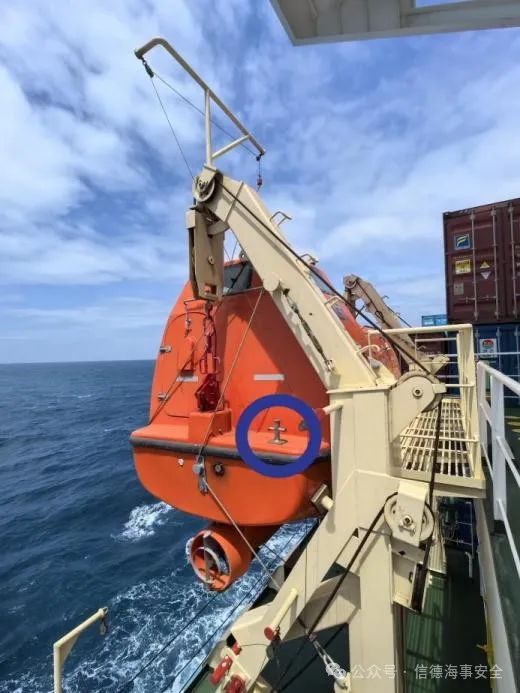
图九
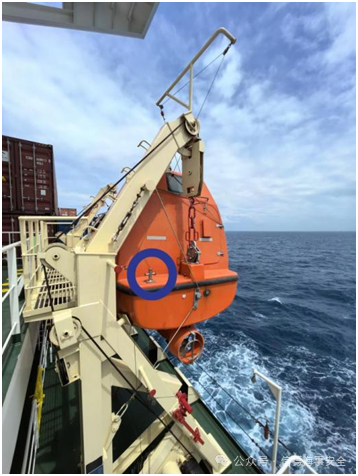
图十
LSA CODE CV/5.1.1.10
除另有明文规定之外,每艘救助艇都应提供有效的舀水或自动舀水设施。
Unless expressly provided otherwise, every rescue boat shall be provided with effective means of bailing or be automatically self-bailing.
本款规定看似两者区别,但是再来分析下述条款
LSA CODE CV/4.4.8.25
如果救生艇不是自动舀水的,应为有效的舀水配备1只手摇泵(图十一)。
If the lifeboat is not automatically self-bailing, a manual pump suitable for effective bailing.
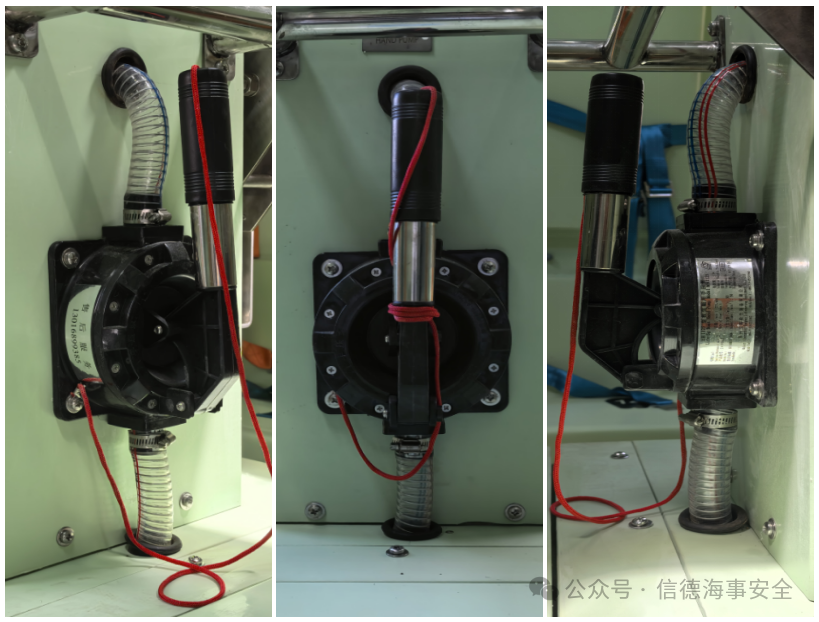
图十一
说明本款也不是二者区别。
7、LSA CODE CV/5.1.1.11/5.1.1.12不是两者区别。
(二)LSA CODE CV/5.1.2救助艇属具
在救助艇属具的众多规定中,仅有两款规定看似两者区别,分别是LSA CODE CV/5.1.2.2.5和5.1.2.2.6,现具体分析如下:
1、LSA CODE CV/5.1.2.2.5
每艘救助艇的正常属具应包括足够长度和强度的首缆1根,附连在4.4.7.7要求的脱开装置,并设置在救助艇的前端。
The normal equipment of every rescue boat shall consist of a painter of sufficient length and strength, attached to the release device complying with the requirements of paragraph 4.4.7.7 and placed at the forward end of the rescue boat.
再来看救生艇在首缆方面的要求:
LSA CODE CV/4.4.8.7
有效的首缆2根,其长度不小于从救生艇存放位置至最轻载航行水线距离的2倍或15m,取其长者。
Two efficient painters of a length equal to not less than twice the distance from the stowage position of the lifeboat to the waterline in the lightest seagoing condition or 15 m, whichever is the greater.
由此两款规定可以得知,不是兼作救生艇的救助艇应配备1根首缆,兼作救生艇的救助艇和救生艇一样应配备2根首缆。说明本款也不是二者区别。
2、LSA CODE CV/5.1.2.2.6
每艘救助艇的正常属具应包括长度不少于50m的可浮索1根,具有足够拖带5.1.1.7要求的救生筏的强度。
The normal equipment of every rescue boat shall consist of one buoyant line, not less than 50 m in length, of sufficient strength to tow a liferaft as required by paragraph 5.1.1.7.
本款规定就是为了达成前文所述LSA CODE CV/5.1.1.7的目的。而根据LSA CODE CIV/4.4.6.8可知,救生艇虽然也有拖带负荷的要求,但是并没有强制配备拖带可浮索的要求。
由此可见,在LSA CODE CHAPTER V的各款规定中,对于货船全封闭重力式救生艇和兼作救生艇的救助艇来说,仅在拖带装置和拖带可浮索方面的规定是有区别的。
综上所述,在SOLAS和LSA CODE中,对于货船全封闭重力式救生艇和兼作救生艇的救助艇来说,仅在回收时间、回收环索、拖带装置和拖带可浮索这四个方面的规定是有区别的。
参考文献:
LSA CODE 2023 Edition
SOLAS 2024 Edition
因公约法规不断更新,如后续再有关于救生艇和救助艇方面的修正案,本文的各个论点可能就不再适用,望各位谨慎参考。
信德海事网专栏作者 陆相辉
2025.02.01
下面是本轮的一些演习照片

09-18 来源:信德海事网
10-10 来源:信德海事网 苏婉
05-07 来源:信德海事网
01-27 来源:信德海事网
12-21 来源:信德海事网
02-11 来源:信德海事网
09-24 来源:信德海事网
12-30 来源:信德海事网
01-08 来源:蓝盾安检创新工作室
06-30 来源:航运安全新动态